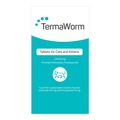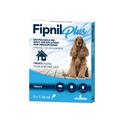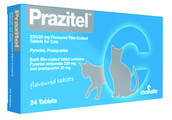The chances are, every dog and every cat will get worms and fleas at some point in their life. Often, infections are manageable but even healthy looking animals may have the beginnings of something more sinister inside them.
If I don't worm/flea them, what might happen?
The consequences of a flea infestation are clear enough and most of us will have been faced with one at least one outbreak in our pet-owning lives. Not only are fleas a nuisance to our pets by causing intense itching and scratching, they can result in more severe reactions such as flea allergy dermatitis.
When it comes to worm, in extreme cases and depending on the type of worm, there may be awful consequences such as intestinal blockages, blockage of blood flow in the heart, inflammation of arteries, anaemia, and even death if left untreated.
Early signs to watch out for include poor growth and a bloated abdomen in puppies/kittens, a dull and brittle coat, increased appetite, weight loss, coughing and abnormal breathing, vomiting and diarrhoea (either may contain whole or fragments of worms!), blood in faeces. A tell-tale sign of tapeworm in particular is small white fragments of worm in the fur around the bottom.
Where does the threat come from?
Throughout their lives, parasites pose risks in many ways and we need to be aware in order to protect our pets properly. Fleas can carry tapeworm larvae, which is why regular de-fleaing is as vital as regular worming.
Their mother
- It is common knowledge that the majority (around 90%) of puppies are born already infected with the Toxocara roundworm, as the larvae can pass from mother to pups via the placenta. After birth, both puppies and kittens can be infected by their mother's milk, as Toxocara larvae can also find their way into mammary ducts. As the mother is a constant source of infection, regular worming every two weeks until weaning is complete is essential.
Environment
- Toxocara roundworm eggs pass out in the faeces of infected pets and mature into an infective stage in the environment . Infective larvae are able to establish infection if eaten.
- Contaminated grass, toys, food and water can transmit infecion, so picking up faeces is very important.
- Nursing mothers are often reinfected when they clean up after their litter, and the cycle continues as larvae are passed on via the milk again
Prey
- Active hunters run greater risk of infection, as prey animals like rabbits and rodents act as middle-men for many nasty types of roundworm and tapeworm.
- Lungworm is a growing concern in the UK and pets can pick up infection by eating slugs and snails. If lungworm is prevalent in your area, it is best to discuss options with your vet, as established infection requires careful treatment because the adults live in the heart. To prevent lungworm, a single dose of a non-prescription wormer is not sufficient. Don't forget that you can always purchase prescription-only medication from us if you get a prescription from your vet :)
Fleas
- Regular flea treatments go hand-in-hand with worming. Fleas feed on the eggs and carry the larvae of the most common tapeworm (Dipylidium caninum) and if a pet accidentally swallows a flea while grooming or gulping down unfortunate prey, you can pretty much guarantee they'll get infected. We'd recommend treating for fleas (and ticks) with Effipro and for all major worms with TermaWorm every month if your pet likes to explore.
Food
- Other types of tapeworm like the Taenia species hibernate in cysts inside muscle tissue of their middle-men, and if meat is fed raw or undercooked, they can survive to infect cats and dogs.
So, how often should I worm my cat/dog?
Adult animals come across a greater variety of worms and depending on their lifestyle, may need worming once a month or once every three months.
- If you have indoor pets with restricted access to wildlife and the outdoors, worming every three months as a precaution will be ideal in most cases, providing that fleas are kept at bay too.
- Pets who spend a lot of time outside hunting or love to scavenge while in the garden are more likely to need worming once a month, along with a regular flea treatment.
- Animals living in large groups should also be wormed more regularly, as risk of roundworm infection from a contaminated environment is higher.
We recommend using TermaWorm Tablets or Prazitel multi-wormer tablets for both dogs and cats. They are ideal for routine worming and monthly treatments if required.
No matter the category a pet falls into, we shouldn't wait for trouble to rear its head before taking action.
If you've found this article helpful, you may be interested to read our other related blogs: Help! My pet's got fleas, Top 5 myths about fleas, Cat fleas, What you need to know about fleas, Spring clean your home from fleas, A guide to defleaing your pet.
Written by: Adam










